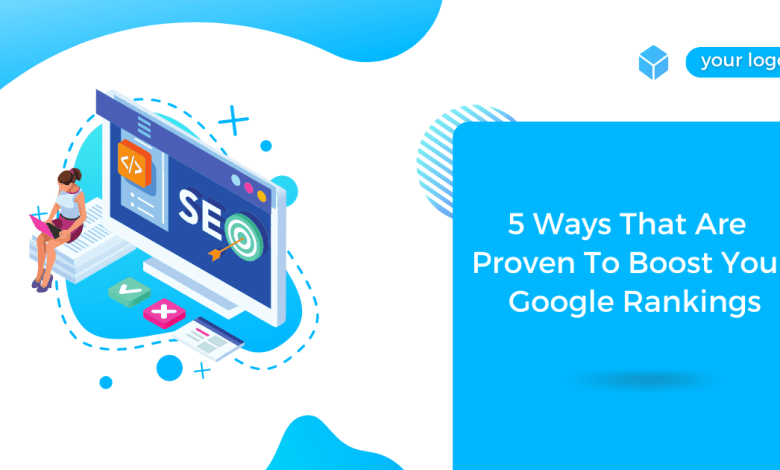5 Ways That Are Proven To Boost Your Google Rankings

The world of search engine optimization (SEO) might seem daunting, but if you focus on these five fundamentals, you’ll be well on ranking success.
Since Google’s inception in 1998, the SEO industry has seen several shifts.
There is one constant, however: search engine rankings are closely tied to organic traffic.
Unlimited traffic may be expected if any of your keywords are included in Google’s index and rank well in search results.
Conversely, even if your website is fantastic, it won’t get many visitors through organic searches if it isn’t visible on the search engine results pages (SERPs).
I’ll explain in detail what has to be done to improve your search engine rankings on Google in this piece. I think the following information will be of equal importance to you.
How Much Time Does It Take To rising In Google’s Search Results?
I’m going to take a chance and say, “It depends” is the correct answer here.
Although I understand this is discouraging and may seem like an excuse, it is true. SEO doesn’t happen in a vacuum, and every circumstance presents a distinct set of factors.
How rapidly the dial can be turned depends on factors such as one’s skill, available funds, the intensity of the competition, and the strength of one’s website.
So, with that in mind, let’s break it down more tangible and analyze what you can do to make things happen sooner rather than later.
When asked how long it takes for Google to index new or updated information, John Mueller, a Google search representative, replied “many hours to several weeks” during an episode of AskGooglebot in June of 2021. He also noted that just because a page is indexed doesn’t imply that it will rank for anything immediately away, if ever.
Given the complexity of the issues involved, we shouldn’t anticipate significant changes in search engine rankings soon.
Mueller has previously said that it may take many months, or perhaps a year, for significant improvements to your website’s design and function to be reflected in search engine rankings.
However, this doesn’t imply that you should relax after upgrading your site. Among the suggestions he made for accelerating the indexing process were the following:
- Optimizing your server and website for speed reduces the likelihood of server overload.
- New page links should be shown prominently.
- Not creating category page filters or other unneeded URLs.
- Using user submission techniques like uploading sitemap files and employing the URL inspection tool.
Finally, Mueller said the best approach to be ranked is to develop high-quality material that searchers would find valuable. Make your site “amazing,” in his words.
Maximizing Your Google PageRank
Getting into the top 10 search engine results pages (SERPs) in under a year requires a lot of effort, ability, and occasionally chance.
And this brings us full round to our original topic: how to raise your Google page rank.
Here are five actions you should do to get your website to the top page of Google and increase sales and conversions.
1. Establish a solid base
Even the most exemplary SEO efforts might fail if the website’s structure and information architecture are poorly designed.
The quality of your search engine rankings will suffer if your website is cumbersome for visitors and Google to crawl. Focus on the Core Web Metrics.
Get Your SEO Done With A Technical Audit
Google’s ranking system is based on an algorithm that uses hundreds of signals, machine learning, and artificial intelligence.
However, if you stick to the fundamentals, you’ll be ahead of the game. Learn the fundamentals of what makes a good SEO audit.
2. Provide a Superb User Experience
According to Google, “page experience” refers to “a collection of signals that assess how people perceive the experience of engaging with a web page beyond its basic information value, both on mobile and desktop platforms.”
The Essence of the Internet
Both mobile and desktop site speeds need to be constantly monitored and optimized. Largest Contentful Paint (LCP), First Input Delay (FID), and Cumulative Layout Shift (CLS).
Data Storage Capacity
Use the application you’re most comfortable with to adjust the image’s file size.
You may reduce the image size even more with tools like Optimizilla, Image Recycle, and Kraken.io before submitting the file.
Last but not least, before publishing a picture, check its proportions to ensure they suit the designated image area. This will help keep the live page looking neat and organized.
Caching in Browsers
Numerous resources are downloaded whenever a web page is displayed, and the users’ browsers cache these resource files on their local machines.
This prevents those resources from having to be loaded again whenever the user navigates to a new page.
For most, the best approach to activate caching is by adding code to the web host/server .htaccess file.
Free plugins such as WP SuperCache exist for WordPress to achieve this goal.
Script Management
Before loading multiple JS and CSS files to enrich your site, be sure you need those additional augmentations since they slow down your website.
You may also minimize your files by removing unnecessary data, including comments, for optimal performance.
And if you can combine many scripts into one, do it. That way, there will only be one fetching call to load all the hands to the server.
We’ve compiled a set of resources to assist you in tracking and measuring key metrics related to the Core Web.
Mobile Friendly
With the growth of search and the mobile-first index, your website must pass the Mobile-Friendly Test.
According to Google, “… our crawling, indexing, and ranking technologies have usually utilized the desktop version of a page’s content… For indexing and ranking purposes, we will prioritize the page’s mobile version.
It will help to double down search intent and performance to prevent mobile ranking concerns.
HTTPS
Make sure the connection to your site is secure. If the page isn’t provided over HTTPS, discover how to make it safe.
No Intrusive Interstitials
Intrusive interstitials are website features that cover other information, usually for promotional purposes.
3. Google-Friendly Web Design Is Crucial
Writing unique content that keeps readers interested until the last paragraph is a given.
Beginning with a brief synopsis that outlines the anticipated content of the article is a great way to get the attention of your intended audience and get them interested in reading more.
Now, some of the most delicate things you can do to optimize your content for Google are:
Give Google a sense of your page’s focus.
Add structured data to all of your site’s pages to do this. Google will be able to deduce the subject matter of your article with ease.
According to Google’s standards, the schema.org format is the way to go. Recipes, companies, goods, and writers are all valid schemas.
Please Use Short Titles
Long titles are bad for SEO and will drive away readers since they can’t quickly grasp the information they provide.
Keep the title length between 135 and 159 characters to ensure it displays correctly in search engine results. Search engine optimization add-ons might help you spot titles with too many words.
Create Original Headings and Meta Descriptions
While titles and meta descriptions do not directly affect your website’s ranking, they are essential in conveying the value of your content on search engine results pages (SERPs).
When executed correctly, they may enhance traffic by increasing the click-through rate.
Create one-of-a-kind titles by incorporating a focus keyword into a brief, engaging description.
You should be aware that Google will produce generic meta descriptions for your sites if you don’t include your original and eye-catching ones using your target keywords.
It stands to reason that the ones created automatically won’t do as much for your site as those you take the time to construct carefully. However, it would help if you avoid keyword stuffing in the names and descriptions.
Use Precise Language Inside Anchor Links
If you want your material to be seen by search engines and ranked for a specific term, you must quickly get to the point.
Many websites mistakenly employ unclear and elusive anchor texts to connect to other pages within their site.
This is a significant error since it will not be a clear enough anchor to your visitors and even the search engines.
4. Optimize For Search Intent
The development of the current search has its origins in Hummingbird, subsequently complemented by Rankbrain and eventually BERT.
The ultimate aim for Google is to better comprehend the context of a search to deliver results that match the intent of a particular query. It’s crucial to Google’s long-term health.
Standard search (or user) intent includes the following four categories:
- Navigational – looking for a specific page on a website.
- Educative, or a quest for data.
- Before making a commercial purchase, I search for information (such as reviews).
- Commercial, or a search with the intent of making a purchase (where to buy).
The Importance of Search Intent Optimization
First, search the search engine results pages (SERPs) for the term you want to rank for. You won’t get high rankings if the top results aren’t relevant to what you have on your website. If Google determines that a search aims to gather information, yet your website is meant to facilitate a financial transaction, your page will likely suffer in search engine rankings.
- If the top results do not correspond to your search’s objective, you have two options:
- Edit your page to meet the purpose.
- To get the desired effect, start a new page.
5. Enhance your site’s internal linking structure.
Links on your site need to be carefully placed, and you should check that they all operate often. Below are some tips that can help you become a better link player.
Connective Structures
One efficiency trick often overlooked is limiting the number of pages a user must go through before returning to the homepage.
A practical internal linking method will ensure that your most important content is shown prominently.
A good strategy is to include a section on your homepage with buttons for your “Best-Selling Products” or “Top Categories.”
Resolve Duplicate Content and Missing Links
Website owners that don’t care about their visitors’ experiences may fail to fix broken links.
Crawling your site using a tool like Sitebulb makes detecting and fixing 404 problems a breeze.
Retrieve All Mentions From Your Site
Set up a Google Alert to monitor any mentions of your brand online, and take back control of your online reputation.
And if you find any mentions of your site that don’t include a link back, make sure to ask the webmaster to add one.
Takeaway
The world of search engine optimization (SEO) may appear daunting, and it’s simple to get stuck in overthinking and never take action.
Still, even in 2022, if you pay attention to the fundamentals we’ve discussed, you’ll be well-positioned for success in the digital realm.
Up next:
- Google Rankings
- Google Rankings
- Google Rankings
- Google Rankings
- Google Rankings
More Resources:
- Best uses SEO keywords tools in 2022
- Why you start SEO outsourcing in 2022
- How to apply Advanced SEO in your website in 2022



